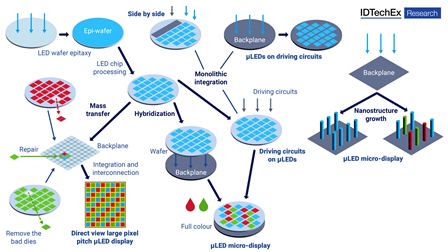Author: Dr Xiaoxi He, Research Director at IDTechEx
In a world increasingly driven by the demand for stunning visual experiences, Micro-LED displays have emerged as a disruptive technology, promising to redefine how people perceive and interact with the world through screens. With global dynamics rapidly evolving, it is essential to understand how this groundbreaking technology is shaping the future of the display industry. IDTechEx’s report “Micro-LED Displays 2024-2034: Technology, Commercialization, Opportunity, Market and Players” explores various angles of Micro-LED displays.
The display revolution
LCD manufacturing is relocating to mainland China, driven by cost efficiency and improved production lines, while other regions are exiting the LCD business. Samsung, LG Display, Panasonic, JDI, and several Taiwanese companies have either shifted focus or reduced investments in LCD production.
Korean companies dominate production in the OLED segment due to their mature technology, comprehensive supply chains, and strong upstream support. Samsung and LG lead in small/mid-sized and large OLED panels, respectively. Quantum dot (QD) technology, known for enhancing color gamut through photoluminescence, is emerging as a strong competitor in the market.
The emergence of Micro-LED displays is nothing short of a revolution. With a focus on creating sharper, brighter, and more power-efficient displays, this technology is poised to disrupt traditional display solutions. But what exactly sets Micro-LED apart from the rest? Let’s explore.
Micro meets macro, a game-changer
MicroLED displays are built on the foundation of self-emissive inorganic LEDs, acting as subpixels. These LEDs are usually in the micrometer range, without package nor substrate, and therefore are transferred in a way different from traditional pick & place techniques.
The key to Micro-LED’s success lies in its unique value propositions. Not only do these displays offer stunning visual clarity, high luminance, fast refresh rate, low power consumption, high dynamic range, and high contrast, but they also provide transparency, seamless connections, sensor integration, and the promise of an extended lifetime. Such features make Micro-LED a game-changer in the display industry.
The evolution continues
While the disruption begins with Micro-LED, it does not end there. These displays not only meet the demands of existing applications but also create entirely new possibilities.
For the former, eight applications are addressed most: augmented/mixed reality (AR/MR), virtual reality (VR), large video displays, TVs and monitors, automotive displays, mobile phones, smartwatches and wearables, tablets, and laptops.
However, recently, IDTechEx have observed a clear trend that most efforts are put on only a few applications such as large video displays/large TVs, Smartwatches/wearables, and augmented reality.

Navigating the shift
When talking about Mini-LED and Micro-LED, the LED size is a very common feature to distinguish the two. Both Mini-LED and Micro-LED are based on inorganic LEDs. As the names indicate, Mini-LEDs are considered as LEDs in the millimeter range, while Micro-LEDs are in the micrometer range. However, the distinction is not so strict in reality, and the definition may vary from person to person. However, it is commonly accepted that micro-LEDs are under 100 µm and even under 50 µm. While mini-LEDs are much larger.
When applied in the display industry, size is just one factor when talking about Mini-LED and Micro-LED displays. Another feature is the LED thickness and substrate. Mini-LEDs usually have a large thickness of over 100 µm, largely due to the existence of an LED substrate. While Micro-LEDs are usually substrateless, and therefore the finished LEDs are extremely thin.
A third feature that is used to distinguish the two is the mass transfer techniques that are utilized to handle the LEDs. Mini-LEDs usually adopt conventional pick-and-place techniques, including surface mounting technology. Every time, the number of LEDs that can be transferred is limited. For Micro-LEDs, millions of LEDs usually need to be transferred when a heterogenous target substrate is used; therefore, the number of LEDs to be transferred at a time is significantly larger, and thus, a disruptive mass transfer technique should be considered.
As the industry transitions from Mini-LED to Micro-LED, challenges abound. However, the rapid penetration of Mini-LED displays has laid the groundwork for the future of Micro-LED. The supply chain becomes more robust with each step, and expertise accumulates.
The IDTechEx report
To fully grasp the potential of Micro-LED displays, a comprehensive understanding is needed of the technology, market landscape, and the players driving this revolution. IDTechEx’s report, “Micro-LED Displays 2024-2034: Technology, Commercialization, Opportunity, Market and Players” is the guide to navigating the exciting world of Micro-LED.

This report delves into the technology assessment, market status analysis, supply chain insights, player activities, business opportunities, and application interpretations. Whether the reader is in display manufacturing, LED supply, materials, R&D, technology provision, or investment, this report equips you with the knowledge needed to make strategic decisions and thrive in the evolving display industry.
Discover the future of visual excellence with Micro-LED displays. Find out more about the IDTechEx report, including downloadable sample pages, by visiting www.IDTechEx.com/MicroLED.




